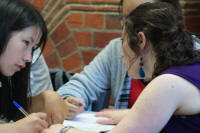A visualisation exercise for a Delta lesson

Only do this after you have worked through the guides to all four teaching
criteria categories.
To do that, start by clicking
here.
This is a final exercise you can do to prepare
yourself for an assessed lesson.
It is a 3-step process which will take around 30 minutes of your
time but will repay you handsomely.
(It is a visualisation exercise and for more on how to use such
things in the classroom there is a
guide to using visualisation exercises on this site.)
 |
Step 1: learn the plan |
You wrote the plan for the lesson carefully but you do not want to be continually referring to it in the lesson for five connected reasons:
- It distracts you.
- It encumbers you with a piece of paper in your hand or it means you have to keep returning to your desk / table to check the notes.
- It gives the impression that you are reading from a script and that reduces your learners' confidence. Learners expect their teachers to be knowledgeable and constantly referring to notes creates a credibility gap.
- It implies that you haven't properly prepared and thought through the plan.
- While you are checking your lesson plan notes, you lose contact with the class and you can't see what's happening.
What the following is intended to help you achieve is analogous
to speaking without notes. You do not have to be a great
orator to achieve that – just well prepared and alert.
Most people will have a set of brief notes (not the full plan)
available as a reassurance. Try not to need it.
So, now, sit down with the plan and read through the procedure.
Then put it out of sight and see if you can recite the stages of the
lesson and what happens at each stage. Think of it as a
narrative rather than a set of stages and it'll be easier to recall
the sequence of events.
If you can't, read and re-read the procedure until you can do
this easily.
The extra spin-off from this activity, incidentally, is that it may
help you to notice if the plan is as coherent and orderly as you
thought it was. It's not too late to rearrange things.
 |
Step 2: run though the steps mentally |
Now shut your eyes and see if you can imagine what you will say
at the end of each section and the beginning of the next from the
opening of the lesson till the end.
For example:
- How will you begin the lesson?
- What will you say?
- How will the learners react?
- How will you introduce the lesson's topic?
- What will you say?
- How will the learners respond?
- How will you start the first procedure / task?
- What instructions will you give for each activity and every
task?
- What will you do?
- What will the learners do?
- How will you introduce the last procedure / activity?
- What's it for?
- What will you say?
- What will the learners do?
- How will you signal that the end of the lesson has been
reached?
etc.
Make sure you can do this easily for each and every stage.
Now do it again.
 |
Step 3: visualise the lesson |
Find somewhere comfortable to sit or lie and, with your eyes closed, visualise the whole lesson from start to finish. In particular focus on the following, using your memory of the five little pictures to help you:
- What you will say:

- focusing and introducing the topic
- instructions
- explanations
- directions
- checking questions
etc.
- Where you will be:

- by the board
- with pairs or groups
- standing out
- at the back
- at the front
etc.
- What you will be doing:

- helping
- taking notes
- listening
- explaining
- moving around
etc.
- What the learners will be doing:

- listening to you
- taking notes
- responding to your questions
- talking to each other
- talking in groups
- talking to the whole class
etc.
- What you will do if:

- the equipment breaks down?
- the learners don't understand your instructions?
- the learners have more trouble with the tasks than you expect?
- the learners finish tasks more quickly than you expect?
Repeat the exercise as many times as you like. Each time you do it, it should get easier and faster.
If you have time, do this exercise again just before the lesson
so that all the stages and all the activities you intend to carry
out are clear in your mind.
Then you can relax and just get on with your job.
Easy.
